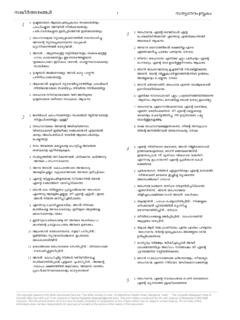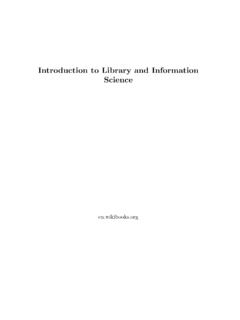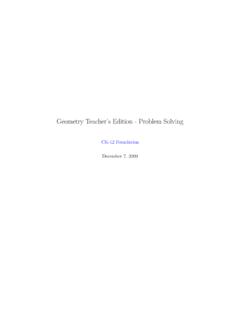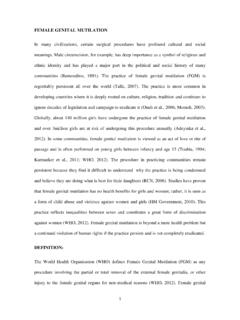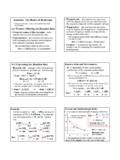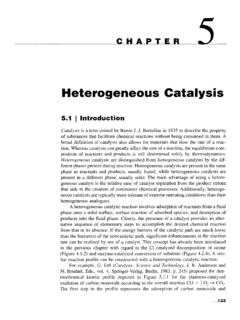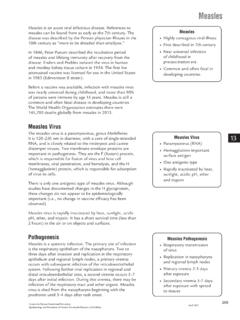Transcription of Introduction to Chemical Engineering Processes/Print Version
1 Introduction to Chemical Engineering Processes/Print Version From Wikibooks, the open-content textbooks collection Contents [hide]. 1 chapter 1: Prerequisites o Consistency of units Units of Common Physical Properties SI (kg-m-s) System Derived units from the SI system CGS (cm-g-s) system English system o How to convert between units Finding equivalences Using the equivalences o Dimensional analysis as a check on equations o chapter 1 Practice Problems 2 chapter 2: Elementary mass balances o The "Black Box" approach to problem-solving Conservation equations Common assumptions on the conservation equation o Conservation of mass o Converting Information into Mass Flows - Introduction o Volumetric Flow rates Why they're useful Limitations How to convert volumetric flow rates to mass flow rates o Velocities Why they're useful Limitations How to convert velocity into mass flow rate o Molar Flow Rates Why they're useful Limitations How to Change from Molar Flow Rate to Mass Flow Rate o A Typical Type of Problem o Single Component in Multiple processes : a Steam Process Step 1.
2 Draw a Flowchart Step 2: Make sure your units are consistent Step 3: Relate your variables So you want to check your guess? Alright then read on. Step 4: Calculate your unknowns. Step 5: Check your work. o chapter 2 Practice Problems 3 chapter 3: Mass balances on multicomponent systems o Component Mass Balance o Concentration Measurements Molarity Mole Fraction Mass Fraction o Calculations on Multi-component streams Average Molecular Weight Density of Liquid Mixtures First Equation Second Equation o General Strategies for Multiple-Component Operations o Multiple Components in a Single Operation: Separation of Ethanol and Water Step 1: Draw a Flowchart Step 2: Convert Units Step 3.
3 Relate your Variables o Introduction to Problem Solving with Multiple Components and processes o Degree of Freedom Analysis Degrees of Freedom in Multiple-Process Systems o Using Degrees of Freedom to Make a Plan o Multiple Components and Multiple processes : Orange Juice Production Step 1: Draw a Flowchart Step 2: Degree of Freedom analysis So how to we solve it? Step 3: Convert Units Step 4: Relate your variables o chapter 3 Practice Problems 4 chapter 4: Mass balances with recycle o What Is Recycle? Uses and Benefit of Recycle o Differences between Recycle and non-Recycle systems Assumptions at the Splitting Point Assumptions at the Recombination Point o Degree of Freedom Analysis of Recycle Systems o Suggested Solving Method o Example problem: Improving a Separation Process Implementing Recycle on the Separation Process Step 1: Draw a Flowchart Step 2: Do a Degree of Freedom Analysis Step 3: Devise a Plan and Carry it Out o Systems with Recycle: a Cleaning Process Problem Statement First Step: Draw a Flowchart Second Step.
4 Degree of Freedom Analysis Devising a Plan Converting Units Carrying Out the Plan Check your work 5 chapter 5: Mass/mole balances in reacting systems o Review of Reaction Stoichiometry o Molecular Mole Balances o Extent of Reaction o Mole Balances and Extents of Reaction o Degree of Freedom Analysis on Reacting Systems o Complications Independent and Dependent Reactions Linearly Dependent Reactions Extent of Reaction for Multiple Independent Reactions Equilibrium Reactions Liquid-phase Analysis Gas-phase Analysis Special Notes about Gas Reactions Inert Species o Example Reactor Solution using Extent of Reaction and the DOF.
5 O Example Reactor with Equilibrium o Introduction to Reactions with Recycle o Example Reactor with Recycle DOF Analysis Plan and Solution Reactor Analysis Comparison to the situation without the separator/recycle system 6 chapter 6: Multiple-phase systems, Introduction to phase equilibrium 7 chapter 7: Energy balances on non-reacting systems 8 chapter 8: Combining energy and mass balances in non-reacting systems 9 chapter 9: Introduction to energy balances on reacting systems 10 Appendix 1: Useful Mathematical Methods o Mean and Standard Deviation Mean Standard Deviation Putting it together o Linear Regression Example of linear regression How to tell how good your regression is o Linearization In general Power Law Exponentials o Linear Interpolation General formula Limitations of Linear Interpolation o References o Basics of Rootfinding o Analytical vs.
6 Numerical Solutions o Rootfinding Algorithms Iterative solution Iterative Solution with Weights Bisection Method Regula Falsi Secant Method Tangent Method (Newton's Method). o What is a System of Equations? o Solvability o Methods to Solve Systems Example of the Substitution Method for Nonlinear Systems o Numerical Methods to Solve Systems Shots in the Dark Fixed-point iteration Looping method Looping Method with Spreadsheets Multivariable Newton Method Estimating Partial Derivatives Example of Use of Newton Method 11 Appendix 2: Problem Solving using Computers o Introduction to Spreadsheets o Anatomy of a spreadsheet o Inputting and Manipulating Data in Excel Using formulas Performing Operations on Groups of Cells Special Functions in Excel Mathematics Functions Statistics Functions Programming Functions o Solving Equations in Spreadsheets: Goal Seek o Graphing Data in Excel Scatterplots Performing Regressions of the Data from a Scatterplot o Further resources for Spreadsheets o Introduction to MATLAB.
7 O Inserting and Manipulating Data in MATLAB. Importing Data from Excel Performing Operations on Entire Data Sets o Graphing Data in MATLAB. Polynomial Regressions Nonlinear Regressions (fminsearch). 12 Appendix 3: Miscellaneous Useful Information o What is a "Unit Operation"? o Separation processes Distillation Gravitational Separation Extraction Membrane Filtration o Purification Methods Adsorption Recrystallization o Reaction processes Plug flow reactors (PFRs) and Packed Bed Reactors (PBRs). Continuous Stirred-Tank Reactors (CSTRs) and Fluidized Bed Reactors (FBs). Bioreactors o Heat Exchangers Tubular Heat Exchangers 13 Appendix 4: Notation o A Note on Notation o Base Notation (in alphabetical order).
8 O Greek o Subscripts o Embellishments o Units Section/Dimensional Analysis 14 Appendix 5: Further Reading 15 Appendix 6: External Links 16 Appendix 7: License o 0. PREAMBLE. o 1. APPLICABILITY AND DEFINITIONS. o 2. VERBATIM COPYING. o 3. COPYING IN QUANTITY. o 4. MODIFICATIONS. o 5. COMBINING DOCUMENTS. o 6. COLLECTIONS OF DOCUMENTS. o 7. AGGREGATION WITH INDEPENDENT WORKS. o 8. TRANSLATION. o 9. TERMINATION. o 10. FUTURE REVISIONS OF THIS LICENSE. [edit] chapter 1: Prerequisites [edit] Consistency of units Any value that you'll run across as an engineer will either be unitless or, more commonly, will have specific types of units attached to it.
9 In order to solve a problem effectively, all the types of units should be consistent with each other, or should be in the same system. A system of units defines each of the basic unit types with respect to some measurement that can be easily duplicated, so that for example 5 ft. is the same length in Australia as it is in the United States. There are five commonly-used base unit types or dimensions that one might encounter (shown with their abbreviated forms for the purpose of dimensional analysis): Length (L), or the physical distance between two objects with respect to some standard distance Time (t), or how long something takes with respect to how long some natural phenomenon takes to occur Mass (M), a measure of the inertia of a material relative to that of a standard Temperature (T), a measure of the average kinetic energy of the molecules in a material relative to a standard Electric Current (E), a measure of the total charge that moves in a certain amount of time There are several different consistent systems of units one can choose from.
10 Which one should be used depends on the data available. [edit] Units of Common Physical Properties Every system of units has a large number of derived units which are, as the name implies, derived from the base units. The new units are based on the physical definitions of other quantities which involve the combination of different variables. Below is a list of several common derived system properties and the corresponding dimensions ( denotes unit equivalence). If you don't know what one of these properties is, you will learn it eventually Mass M Length L. Area L^2 Volume L^3. Velocity L/t Acceleration L/t^2. Force M*L/t^2 Energy/Work/Heat M*L^2/t^2.


